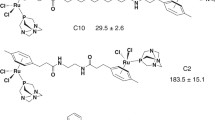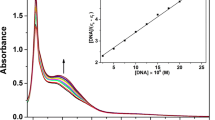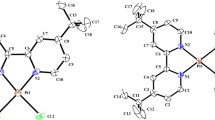Abstract
The goal of this study is to establish the nature of pentammineruthenium(III) binding to DNA in intact mouse liver nuclei. Also, we wish to determine whether the nucleosomal organization of mouse chromatin has a substantial effect on the relative Ru(III) binding levels of internucleosomal and nucleosomal core DNA. These questions are important because ammineruthenium compounds share chemical and biological properties with the cis-dichlorodiammineplatinum(II) or cisplatin chemotherapeutic agent. Therefore, they represent a potential class of new chemotherapeutic agents. We find that in intact nuclei the predominant DNA binding site for pentammineruthenium(II), followed by air oxidation to pentammineruthenium(III), is N-7 guanine, as is the case with cisplatin. Also, the Ru(III) distribution between internucleosomal and nucleosomal core DNA was found to be nearly identical as probed with three non-specific deoxyribonucleases.
Similar content being viewed by others
References
Rosenberg B: Platinum complexes in biological systems. In: Metal Ions in Biological Systems 11: Marcel Dekker, Inc, NY 1980, pp 1–30
Clarke MJ: Oncological implications of the chemistry of ruthenium. In: Metal Ions in Biological Systems 11: Marcel Dekker Inc, NY 1980, pp 231–283
Kelman AD, Clarke MJ, Edmonds SD, Peresie HJ: Inhibition of cell growth by ammineruthenium compounds. J Clin Hemat Oncol 7:274–277, 1977
Giraldi T, Sava G, Bertoli G, Mestroni G, Zassinovich G: Organismal effects of ammineruthenium compounds. Cancer Res 37:2662–2666, 1977
Yasbin RE, Mathews CR, Clarke MJ: Ammineruthenium compound mutagenic activity in the ames assay. Chem Biol Interactions 31:355–365, 1980
Marx KA, Seery C, Malloy P, Clarke MJ: unpublished results.
Clarke MJ, Buchbinder M, Kelman AD: Binding of pentaamineruthenium(III) to double-helical and single stranded DNA. Inorg Chimica Acta 27:87–88, 1978
Clarke MJ, Jansen B, Marx KA, Kruger R: Biochemical effects of binding [(H20)(NH3)5Ru(II)] to DNA and oxidation to (NH3)5Ru(III)n-DNA. Inorg Chimica Acta 124:13–28, 1986
Clarke MJ: The chemistry of ammineruthenium complexes. In: Martel (ed) Inorganic Chemistry in Biology and Medicine. American Chemical Society, Wash, DC 1980, pp 157–180
Clarke MJ: Ammineruthenium compounds in relation to other chemotherapeutic agents. In: Lippard (ed) The Chemistry and Biochemistry of Platinum, Gold and Other Chemotherapeutic Agents. American Chem Soc, Wash, DC 1983, pp 335–354
Kish V, Peterson T: Gel electrophoretic methods in cell biology. Methods in Cell Biol 17:377–399, 1978
Clarke MJ, Taube H: Pentaamineruthenium-guanine complexes. J Amer Chem Soc 96:5413–5419, 1974
Clarke MJ: Electrochemistry, synthesis and spectra of pentaamineruthenium(III) complexes of cytidine and related ligands. J Amer Chem Soc 100:5068–5075, 1978
Lewin B: Gene expression 2. John Wiley and Sons, New York, 1980, p 350
Gaubatz JW, Chalkley R: Mammalian DNA repeating lengths. Nuc Acids Res 4:3281–3301, 1977
Shaw BR, Herman TM, Kovacic RT, Beaudreau GS, Van Holde KE: Analysis of subunit organization in chicken erythrocyte chromatin. Proc Natl Acad Sci, USA 73:505–509, 1976
Whitlock JP, Simpson RT: Subunit organization of mammalian chromatin. Biochemistry 15:3307–3313, 1976
Lohr D, Corden J, Tatchell K, Kovacic RT, Van Holde KE: Comparative subunit organization of HeLa, yeast and chicken erythrocyte chromatin. Proc Natl Acad Sci USA 74:79–83, 1977
Hewish DR, Burgoyne LA: Regular repeating chromatin structure in liver cells. Biochem Biophys Res Commun 52: 504–510, 1973
Clarke MJ, Bider S, Reenert D, Buchbinder M, Kelman AD: Reduction and subsequent binding of ruthenium ions catalyzed by subcellular components. J Inorg Biochem 12:79–87, 1980
Gullino PM: Biological properties of ammineruthenium complexes. Adv Exp Biol Med 75:521–525, 1976
Lippard SJ, Hoeschele JD: Binding of the antitumor drug cisdiamminedichloroplatinum(II) to DNA. Proc Natl Acad Sci USA 76:6091–6095, 1979
Tullius TD, Lippard SJ: Ethidium bromide changes the nuclease sensitive DNA binding sites of the antitumor drug cis-platin. Proc Natl Acad Sci USA 79:3489–3492, 1982
Manning GS: Polyelectrolyte theory. Quart Rev Biophys 11:179–246, 1978
Chattoraj OK, Gosule LC, Schellman JA: Counterion collapse of DNA. J Mol Biol 121:327–337, 1978
Eickbush TH, Moudrianakis EM: Condensation of DNA under different solution conditions. Cell 13:295–306, 1976
Widom J, Baldwin RL: Counterion condensation forms toroidal shaped DNA structures. J Mol Biol 144:431–453, 1980
Marx KA, Reynolds TC: Spermidine-condensed PhiX-174 DNA cleavage by micrococcal nuclease: torus cleavage model and evidence for unidirectional circumferential DNA wrapping. Proc Natl Acad Sci USA 79:6484–6488, 1982
Marx KA, Ruben GC: Evidence for hydrated spermidine-calf thymus DNA toruses organized by circumferential DNA wrapping. Nuc Acids Research 11:1839–1854, 1983
Marx KA, Reynolds TC: Ion competition and micrococcal nuclease digestion studies of spermidine-condensed calf thymus DNA. Biochim Biophys Acta 741:279–287, 1983
Marx KA, Ruben GC: Studies of DNA organized in hydrated spermidine-condensed DNA toruses and spermidine-DNA fibres. J Biomolecular structure and dynamics. 1:1109–1132, 1984
Marx KA, Ruben GC: A study of PhiX-174 DNA torus and lambda DNA torus tertiary structure and the implications for DNA self-assembly. J Biomolecular structure and dynamics 4:23–39, 1986
Moore WJ: Physical chemistry. Prentice-Hall, New Jersey, 1964, p 144
Wilson RW, Bloomfield VA: Counterion collapse of DNA with different valence counterions. Biochemistry 18:2192–2196, 1979
Camerini-Otero RD, Sollner-Webb B, Felsenfeld G: The organization of histones and DNA in chromatin: evidence for an arginine rich histone kernel. Cell 8:333–347, 1976
Author information
Authors and Affiliations
Rights and permissions
About this article
Cite this article
Marx, K.A., Kruger, R. & Clarke, M.J. Binding of the transition metal ion [(H20)(NH3)5Ru(II)]2+ to nucleosomal core and internucleosomal DNA. Mol Cell Biochem 86, 155–162 (1989). https://doi.org/10.1007/BF00222615
Received:
Accepted:
Issue Date:
DOI: https://doi.org/10.1007/BF00222615




